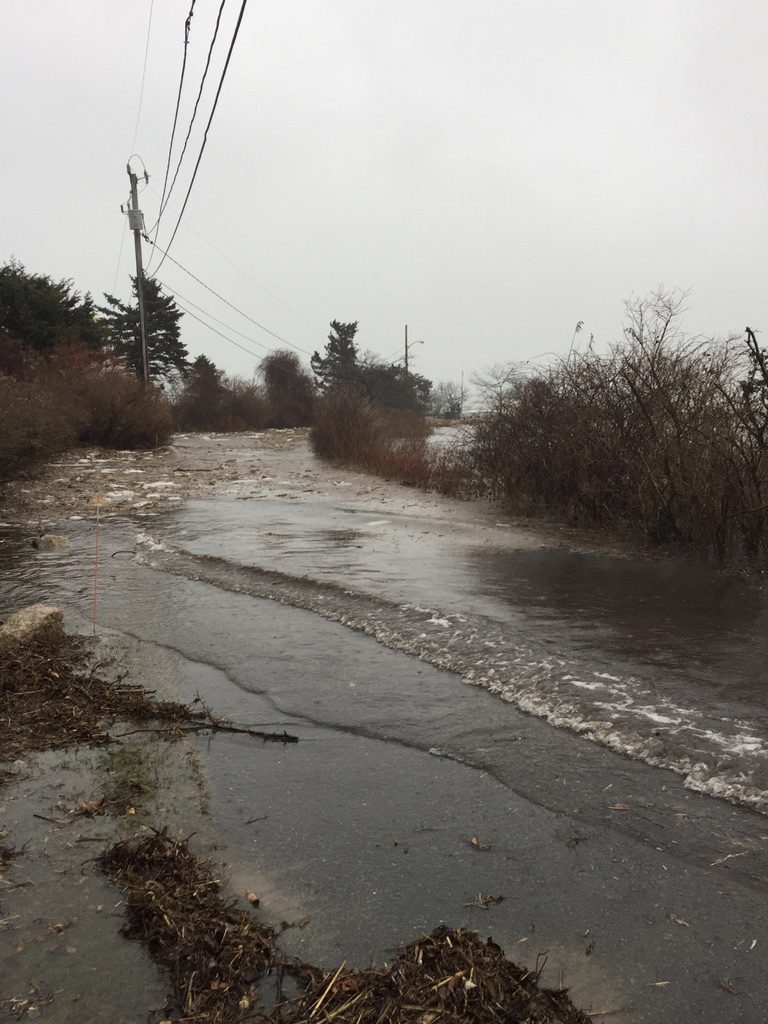
Coastal Resilience is the ability of a community to bounce back after major storms. It is anticipated that “100 year storms” will become “10 year storms” by 2050! That means the chance off occurrence increases from a 1% chance to a 10% chance.
Stormwater Runoff
In 2017 we had two storms that brought 4″ and 7″ of rain in less than one hour. In both instances flooding occurred in the Barnstable Village, on various areas on Route 6A and in the Barnstable Marina parking lot. Local residents have begun lining their properties with sand bags to deflect rainwater off the street from flooding their property.
Rain water runoff from the County Complex parking lot is designed to drain into lagoons behind the Barnstable Tavern. These largely stagnant lagoons are overwhelmed in major rain events. When overwhelmed, these lagoons drain into Barnstable Harbor’s Rendezvous Creek. Pollution and stormwater runoff systems designed and implemented as recently as 20 years ago are not built to meet the magnitude or the frequency of today’s storms.
More frequent and longer duration storm events are predicted. Of course, there’s always the possibility of a major hurricane releasing its fury.

King Tides
King tides coupled with storm surges flooded the Blish Point/Maraspin Creek neighborhood on three different occasions during the winter of 2018. These events flooded homes and businesses with seawater levels never before witnessed. Residents of the Blish Point neighborhood had their homes flooded by seawater from Maraspin Creek Marsh overflow and from breaches across Millway Beach. Spots along Route 6A were flooded and impassable during both of these storms. Coastal structures, piers, bulkheads, and sea walls have suffered significant damage that winter. Aquaculture gear was strewn all over the harbor following the January 4th storm.
Following the January 4th storm, attendees at a Cape Cod Bay stakeholders meeting addressing Coastal Resiliency, commented on the accuracy of the FEMA flood maps.

Coastal Resilience
The future of Barnstable Harbor and Barnstable Village is at stake.
Rain gardens and permeable pavement are fantastic short term steps for mitigating the harmful impacts of stormwater runoff to the harbor and its marshes. Nevertheless, long term solutions must be developed and employed to ensure the long term well being of Barnstable Harbor.
Town planners and citizens must work together to design and implement updated zoning laws that consider a future where rising tides change our coastal landscape and impact our businesses, homes, and infrastructure. Businesses and homeowners themselves must plan for the inevitable future.
Land bank acquisition and preservation of coastal land will allow Barnstable Harbor’s salt marshes to grow and migrate. This evolution of the salt marshes will be integral to preserving a healthy harbor.
This past year’s storms have made it abundantly clear that rising tides and flooding storms are real.
Adaptation
The Rendezvous Lane community has agreed to allow their “green” to be the new location for the sewer pump. This higher elevation will keep the pump safe from storm surge. Additionally a permanent auxiliary generator will be installed.

This adaptation was approved by the Town of Barnstable Conservation Commission in January 2020. Installation of the new pump is anticipated in the fall of 2020.
Rethinking…Adaptation & Rebuilding
Local environmental writer Meera Subramanian published the article article on a local developer’s response to flood loss and rebuilding.
They Know Seas Are Rising But They Are Not Abandoning Their Beloved Cape
Meera reveals Cape Codder’s resilience as well as their ability to change their point of view. A good flooding event can wake all of us up!
